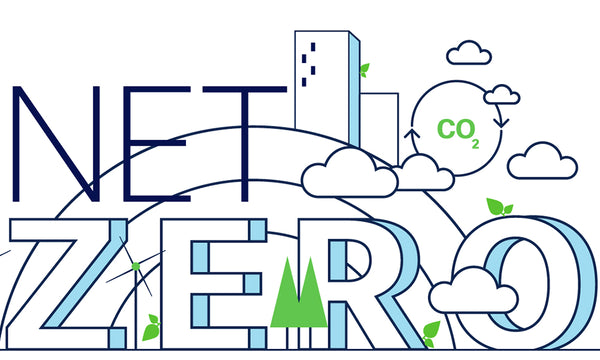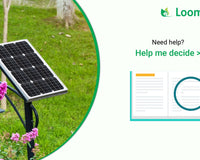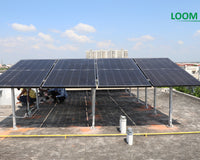Did you know buildings are also a source of emission? Yes, you heard it right. Buildings account for nearly 40% of the country’s total consumption. It is estimated that conventional buildings will constitute ~70% of emissions by 2050 in India. This could be a major threat to India’s green energy targets. Hence the importance of constructing green buildings today to sustain our future. Currently only 5% of the India’s stock account for green buildings.
What is Green Building?
Green buildings are more energy efficient and emit less emissions when compared to the conventional buildings. As the world moves towards sustainable living there is an urgent need to create awareness about green buildings for our future generations.
Some of the advantages of green building are:
- Better Resource Management
- Low maintenance and environmental impact
- Usage of renewable energy which is emission free
- Energy efficiency
- Healthy lifestyle
- Eco-friendly
- Better air quality and water management
- Higher ROI
However, one of the major disadvantages of green buildings currently is the high cost of construction and design.
The recent pandemic has also stressed upon the importance of a healthy lifestyle and individuals now prefer to stay and work at greener places. Green buildings are expected to have better air quality/ ventilation system, sufficient daylight and fresh water availability. Other advantages include reduction in water and energy consumption. Energy saving ranges from 20% to 30% while water savings from 30% to 50%. Green building designing and construction require a focus on incorporating energy efficiency, clean energy and energy management in the infrastructure value chain right from material procurement to construction and certification.
The process usually starts with assessing one’s carbon footprint and projecting the same over the years to come and finally ends with creating a reduction program for the client and establishing a net zero target. These buildings are expected to contribute better to one’s lifestyle and well being by having a positive impact on health and people’s psyche. The Indian government is trying to implement policies highlighting green building in the nation. The green housing scheme can give a huge push to green buildings in India. The Green Rating for Integrated Habitat Assessment (GRIHA) should also promote green buildings. For instance, it is mandatory for government buildings to obtain at least a 3-star rating from GRIHA. Many states are also promoting green buildings through reduction in property taxes and stamp duty, subsidies on capital investment.
According to Maharashtra’s Green Building policy, the buyers of green buildings will be entitled to a property tax rebate for a period of five years from securing the Occupancy Certificate based upon the green building rating.
Building having a five-star, four-star and three-star ratings would get rebate of 10%, 7.5% and 5%, respectively in the property tax. The Maharashtra government would also be signing an MoU with TERI-GRIHA and GBCI-LEED to certify the buildings as green buildings.
Green building makers will get tax exemption to encourage the concept of green building in Indore. Efforts should also be made to recycle and reuse the water going into the drainage.
What is Net Zero Target?

India is a developing country with rapid construction and if this energy is directed towards green building, it will be a win-win for both the economy and the environment. India, which ranks third in terms of greenhouse gas emissions in the world after China and the US, is under immense pressure over its net zero carbon emission target. The country has resolved to attain net zero status by 2070 at estimated investment costs of $10 trillion.
The funds will be focused towards building up renewable energy infrastructure, strengthening energy transmission systems, and establishing green hydrogen capacities. India had earlier committed to cut carbon emissions by 33%-35% by 2030. The US, UK, and China have set a deadline to achieve the net zero target. Saudi Arabia also announced to achieve net zero targets on carbon emissions by 2060.
Countries around the world are setting their net zero targets to reduce the effects of climate change. People and organizations are looking at reducing emissions as well as innovating and investing in cleaner and sustainable lifestyles. Intelligent and smart designing, investing in renewable energy, focusing on energy efficiency and waste reduction can help in attaining a balance.
What is Mission 500GW?

India's current capacity is at just about 101 GW in 2021. This means another 400GW of RE by has to be added by 2030 to meet the commitment. Modi had announced India's intent to achieve 500GW of its installed capacity through non-fossil fuels and 50 per cent of its energy requirement from renewables by 2030, at COP26. Below are top 5 highlights:
Firstly, India will increase its non-fossil energy capacity to 500 GW by 2030.
Secondly, India will fulfil 50% of its energy requirements from renewable energy sources of 2030.
Thirdly, between now & 2030, India will reduce its total projected carbon emissions by one billion tons.
Fourthly, by2030, India will reduce the carbon intensity of its economy by 45% and,
Fifthly by 2070 India will achieve the target of net zero emissions.
Green Building in India
 Infosys Pune Becomes the Largest Campus in the World to Earn LEED Platinum Certification from US Green Building Council.
Infosys Pune Becomes the Largest Campus in the World to Earn LEED Platinum Certification from US Green Building Council.
Key features of Infosys Pune Phase-2 campus are:
> Energy efficiency: 47% reduction in per capita energy consumption in the last eight years
> Water conservation: 38% reduction in per capita water consumption in the last eight years
> 77% solar power used to meet electricity needs of the entire campus this year
Learn more:https://www.infosys.com/newsroom/features/2017/leed-platinum-certification-pune.html
Sources:
Source:
→The case for green buildings in India: https://www.orfonline.org/expert-speak/case-green-buildings-india/
→‘Green building policy’: Maha govt proposes incentives for buyers and developers: https://indianexpress.com/article/cities/pune/green-building-policy-maharashtra-govt-proposes-incentives-for-buyers-and-developers-5437524/
→मास्टर प्लान 2035 पर मंथन शुरू:ग्रीन बिल्डिंग बनाने वालों को टैक्स में छूट, सरकारी मकान भी किराए से मिलें: https://www.bhaskar.com/local/mp/indore/news/tax-exemption-for-green-building-builders-government-houses-should-also-be-given-on-rent-129021988.html
→अमेरिका, सऊदी अरब और चीन के इस ऐलान से बढ़ी भारत की मुश्किल: https://www.aajtak.in/world/story/india-rejects-net-zero-carbon-emission-target-climate-crisis-paris-agreement-glasgow-tlifw-1348889-2021-10-29
→Net Zero: why is it essential? https://www.anthesisgroup.com/achieving-net-zero/
→Green Building Strategy and Design: https://www.anthesisgroup.com/what-we-do/supply-chain-operations/green-building-strategy-and-design/
→Defining a Net Zero Pathway - RE100: https://www.anthesisgroup.com/what-we-do/supply-chain-operations/defining-a-net-zero-pathway/
→Energy Services: https://www.anthesisgroup.com/energy-services/
→Sustainable “Green” Building Design Checklist: https://www.kmbdg.com/news/sustainable-green-building-design-checklist/
→Energy-Efficient Restaurant Systems: https://www.kmbdg.com/news/energy-efficient-restaurant-systems/













2 comments
Maxwell
Nice article! informative article for reader… i also come up with the best solar panel installation services visit https://affordablesolarhartfordct.com
Anna
Thank you so much for sharing a wonderful information among readers, We also provide Solar Panel Services in USA, take a look massachusetts solar panels